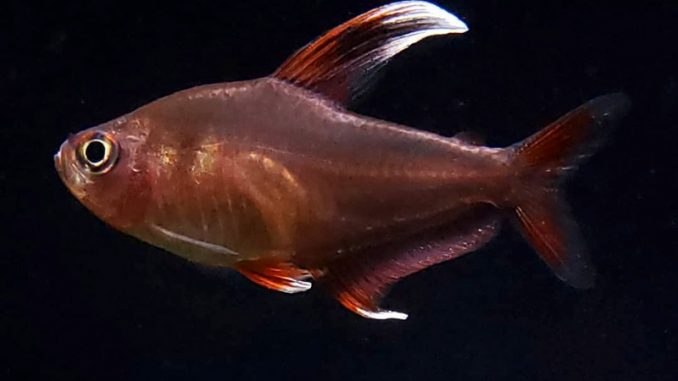
The candy cane tetra is a freshwater tropical fish. This variety of tetra fish is usually commercially tank-bred.
As peaceful fish, candy cane tetras adapt well to a community tank setup with other non-aggressive fish. Candy cane tetras are ideal for beginner and intermediate tropical fishkeeping enthusiasts.
The candy cane tetra is a popular fish because of its pretty rosy salmon-colored body, which gives it a striking appearance in an aquascaped or planted tank.
TABLE OF CONTENTS
Candy Cane Tetra Facts & Overview
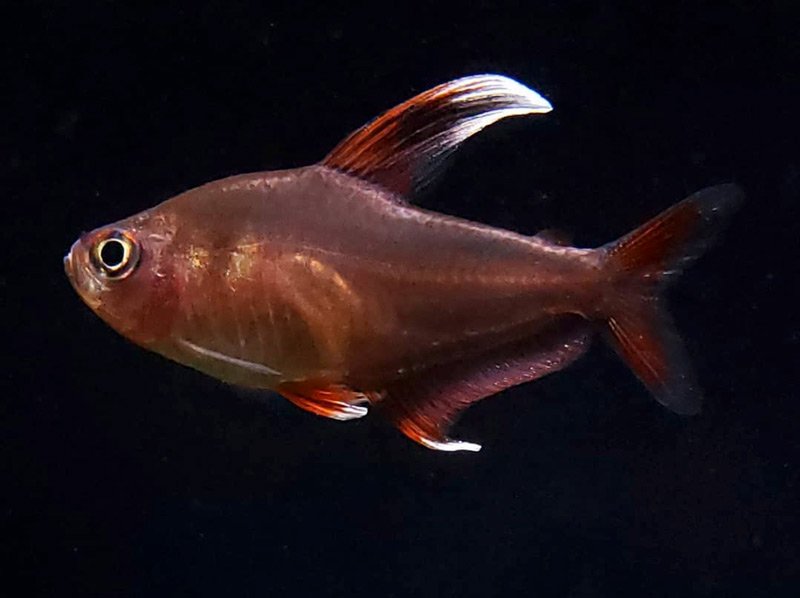
| Category | Rating |
| Care Level | Easy–Moderate |
| Temperament | Peaceful |
| Color | Transparent salmon body with dark red fins; dorsal and pelvic fins are white-tipped |
| Lifespan | ~3–5 years |
| Size | ~2–3 inches |
| Diet | Omnivore |
| Family | Characidae |
| Scientific Name | Hyphessobrycon bentosi |
| Minimum Tank Size | 15 gallons |
| Tank Setup | Freshwater, plants, caves, woodwork, river sand substrate, dimly lit |
| Compatibility | Peaceful, shoaling species |
The tributaries and lakes, home to candy cane tetras, are densely vegetated. Candy cane tetras enjoy the shade the forest canopy provides.
Part of the Characidae family, candy cane tetras are closely related to rosy tetras. They both have a rosy salmon hue. Because of this, the candy cane tetra is sometimes referred to as the false rosy tetra.
Other names for the candy cane tetra include ornate tetra, bentos tetra, white tip tetra, white fin bentosi tetra, white fin ornate tetra, and HY511.
Distribution
Candy cane tetras were discovered in the Amazon basin in South America in 1908.
The candy cane tetra (Hyphessobrycon bentosi) is native to the slow-moving tributaries and floodplain lakes of the Amazon river in Brazil and Peru. The waters of these lakes, streams, and small rivers are clean and rich in tannins and natural acids, giving them a brown or black color.
In their natural habitat, schools of 50 and more candy cane tetras live together. Candy cane tetras eat small invertebrates and plankton.
The population of candy cane tetra is stable and widespread. The International Union for Conservation of Nature and Natural Resources (IUCN) categorizes these fish on the Least Concern list. There are currently no threats to candy cane tetras.
Adult Size & Lifespan
In their natural habitat, candy cane tetras can grow to three inches long. In captivity, they reach two inches in size when mature.
The life expectancy of a candy cane tetra is between three and five years.
Availability
Because candy cane tetras are a popular tropical fish, they are sold in most pet stores. Often, these fish are out of stock.
Currently, these online stores have stock of the candy cane tetra:
A single candy cane tetra costs in the range of $5.99–$8.99, while a school of six costs $23.00–$54.00.
Appearance & Behavior
The candy cane tetra has a deep body, similar to the bleeding heart tetra. Candy cane tetras are transparent pink, rosy, or salmon-colored. The fish’s body is silvery pink because it’s almost translucent.
The fins of a candy cane tetra are dark red. The dorsal and pelvic fin extensions are tipped in white. The eyes of the candy cane tetra have a black line running through them, with a red arc over the top half of the pupil.
Candy cane tetras have a light gray shoulder patch. This gray patch distinguishes the candy cane tetra from its rosy tetra cousin.
The rosy tetra also has a rosy salmon pink body, but the body of the candy cane tetra is more transparent. Rosy tetras also have dark red markings on their fins, but no white tips. The rosy tetra has a black flag on its dorsal fin extension.
Candy cane tetras have sexual dimorphism, meaning they have distinct male and female differences.
Male candy cane tetras have longer pelvic and dorsal fins than their female counterparts. Male candy cane tetras are also bigger and a brighter pink, especially when spawning approaches. The females are duller in color and chubbier, especially when gravid (pregnant or carrying eggs).
Male candy cane tetras are slightly bigger than the females, and their dorsal and pelvic fins are longer.
Typical Behavior
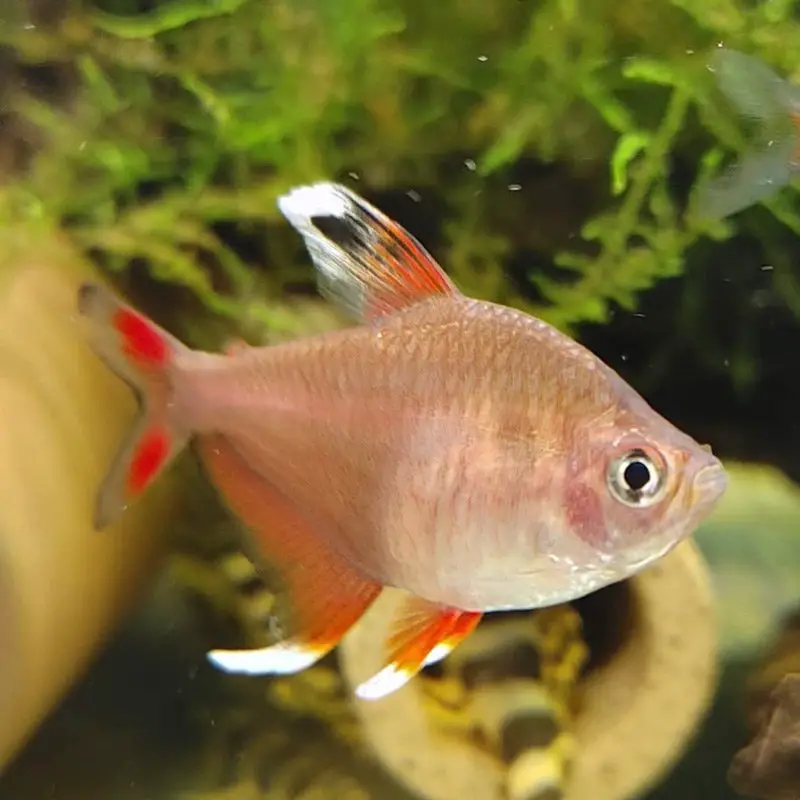
In the wild, candy cane tetras are found in large schools, so keeping a school of fish helps curb behavior problems. Candy cane tetras are peaceful and prefer a tranquil environment.
Candy cane tetras feel stressed when larger, aggressive fish species share their tank. This may cause these tetras to fin nip. The candy cane tetra is also more likely to fin nip when the aquarium is overcrowded. These fish are easily startled by sudden movements or loud sounds.
Candy cane tetra fish are no threat to snails, shrimps, or crabs, and can cohabit a tank with these creatures. Slow swimmers and eaters don’t make good tank mates as tetras are aggressive around food.
In the aquarium, candy cane tetras occupy the mid to upper levels, and they like to hide in caves or amongst the plants. Candy cane tetras sometimes swim and eat in the mid to lower levels of the tank. These fish sleep at night or when the aquarium is dim. They eat several times during the day.
Candy Cane Tetra Care
Caring for the candy cane tetra is relatively easy. This fish is moderately hardy. While candy cane tetras are recommended for intermediate fish enthusiasts, even people with beginner know-how can look after a candy cane tetra.
You should make sure your candy cane tetras are housed in clean water. These fish don’t tolerate changes in your aquarium’s water.
The natural habitat for the candy cane tetra is slow-moving, clean, dark water with submerged plants, roots, and branches. Your aquarium should reflect this. Dim lighting, clean water, and aquascaping with driftwood and floating plants will make your candy cane tetra fish feel at home.
Candy cane tetras are omnivores. These fish eat flake food, tablets or pellets, live food such as worms, shrimp, and little fish, and algae and live plants.
Although candy cane tetras are disease-hardy, bacteria in the tank can introduce illnesses such as skin flukes, dropsy, parasitic and bacterial infestations, and ich.
Disease
Candy cane tetras are resistant to disease. Disease should only affect one or two of your fish if you deal with it early on.
Prevent disease from affecting your candy cane tetras by ensuring your fish live in an environment that closely resembles their natural habitat. A well-balanced diet also contributes to the health of your fish. Happy fish are healthy fish, while stressed fish are more likely to get infected.
The disease can easily be introduced to your aquarium if you add a plant, decorations, other fish, or a substrate that harbors bacteria. You should clean anything before adding it to an established tank to keep everything in balance.
Similar to other tetras, candy cane tetras are vulnerable to a few diseases and infections. These include:
Skin flukes
You will see black or red nodules underneath your fish’s skin. Your fish will race around the tank and will try to scratch their bodies against the sides of the aquarium. Treat a skin flukes outbreak by removing the infected fish and putting it in a bath of 10 mg per liter of potassium permanganate for 10–30 minutes.
Parasitic infestations
Parasitic infestations may include worms or protozoa like ichthyobodo. With ichthyobodo, the skin and gills of your candy cane tetra will turn gray and a blue-gray mucus is produced. Infected fish showcase symptoms like a loss of appetite and lethargy. For treatment, see a fish health specialist.
General bacterial infections
Bacterial infections like columnaris may affect your tetras. You’ll notice ulcers on the scales and cloudy white patches near the gills. Your candy cane tetra will breathe rapidly. Treatment includes antibiotics like Terramycin or copper sulfate.
When you notice that one or a few fish are infected, create a hospital tank to quarantine the sick fish. This helps stop the disease from infecting your whole fish population.
Next, medicate or treat the fish as appropriate for the disease or infection. Change the water in the main tank and vacuum it. Once your fish has received medication, quarantine it for another week to ensure the disease has been completely treated.
Habitat and Tank Requirements
In the Amazon basin’s floodplain lakes and tributaries, candy cane tetras live in the shade that the trees provide. The sandy river or lake bed is littered with leaves, branches, driftwood, tree roots, and aquatic plants. The slow-moving clean water is black or dark brown due to the organic acid and tannins that the dense plant matter releases as it decays.
To ensure your aquarium mimics this natural environment, don’t allow angle filters or powerheads to disturb the water area where your candy cane tetras swim.
Add catappa leaves or aquarium-safe peat to make the water darker. This will have the added benefit of making your pink candy cane tetras even more beautiful.
Clean water is essential, and 30–50% of the aquarium water should be changed every other week. Because the tank is a closed system, water hardness increases when water evaporates. Decaying organic matter, phosphate, and nitrate build up over time. Regular water changes keep these levels in check.
A fine gravel or river sand substrate is recommended. You should aquascape your tank with river rock, driftwood, dry leaves, floating plants, and other aquatic plants. This will replicate the dense vegetation found in the Amazonian water sources
Tank Conditions
Candy cane tetras have specific tank conditions that need to be met to ensure these fish are safe, happy, and healthy.
The minimum tank size should be a 15-gallon aquarium. A school of six candy cane tetras will thrive in a tank size ranging from 15–20 gallons. The more tetras you add to your tank, the bigger the tank should be. This will prevent the behavior issues associated with overcrowding.
Your aquarium should be filled with fresh water at a 3–12 dGH water hardness level. The ideal water temperature for your school of candy cane tetras is 73–82 ℉.
If your candy cane tetras have been commercially tank-bred, then the pH of the water should be in the 6.6–7.8 range. If your tetras were caught in the wild, then the pH should be 6.6.–7.2. No brackish water should be present.
You can add a filter or two to your aquarium. These need to be set up so they don’t increase the flow of the water.
Tank Mates
Candy cane tetras only feel stressed if the aquarium is overcrowded or if they share their tank with aggressive, boisterous, and much larger fish. Candy cane tetras dislike excessive movement, so they shouldn’t be housed with fast-swimmers that cause a lot of water movement. Large fish can prey on candy canes and eat them when the opportunity presents itself.
A school of at least six candy cane tetra is best, as these fish live in large schools in the wild. Candy cane tetras establish their own social hierarchy. Although there may be some scruffs in the family, these tetras aren’t aggressive.
The candy cane tetra gets on best with peaceful fish that are of similar size (medium) and that occupy the mid to lower levels of the aquarium.
The best tank mates for candy cane tetra are the fish closely related to them:
- Rosy tetra
- Black widow tetra
- Bleeding heart tetra
- White skirt tetra
- Lemon tetra
- Red phantom tetra
- Serpae tetra
- And other peaceful tetras
Other fish that can share an aquarium with a school of candy cane tetras are:
- Harlequin rasboras
- Barbs
- Anabantids
- Angelfish
- Discus
- Dwarf cichlids
- Corydoras
- Small loricariids
- Danios
- Guppies
- Smaller gouramis
- Small catfish
- Loaches
- Pencilfish
- Hatchetfish
- Platies
- Other hyphessobrycon or hemigrammus species
Non-fish aquarium species that can be housed with candy cane tetras are snails, shrimp, and crabs.
Diet and Feeding
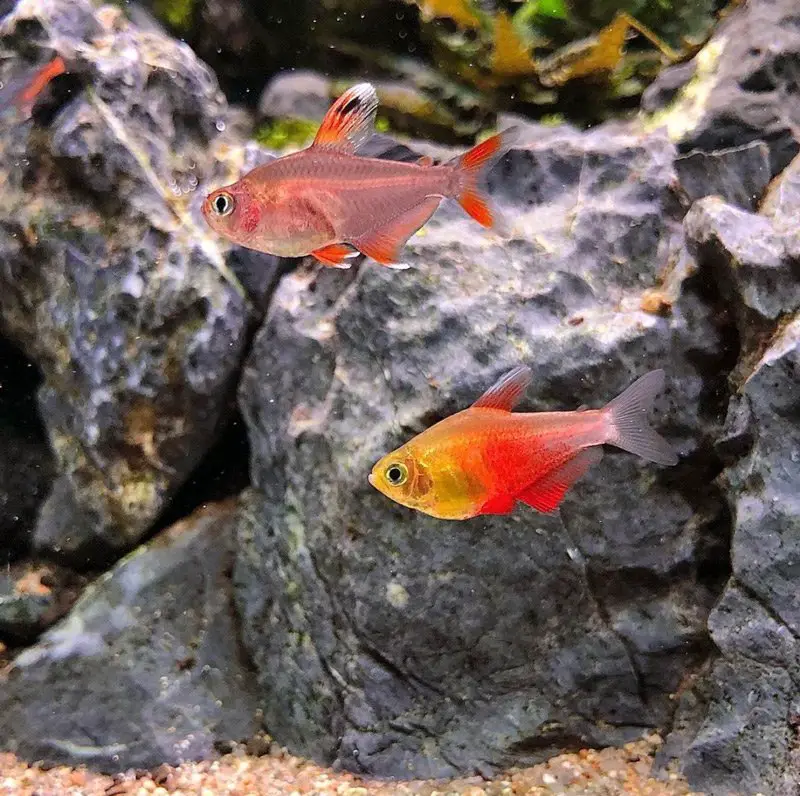
In the wild in the Amazon basin, the omnivorous candy cane tetra eats algae, plankton, and small invertebrates. In your aquarium, your candy cane tetras can also nibble on algae and plankton. These fish thrive on a varied diet that meets their high vitamin requirements.
High-quality fish flake food should comprise 60–80% of your fish’s daily diet. Candy cane tetras like to chase live foods, so you can feed them daphnia, bloodworms, and brine shrimps.
Tubifex worms are another nutritious treat for your candy canes. You can supplement your fish’s diet with pellets or tablets.
Candy cane tetras need to be fed twice during daylight hours. Be careful not to overfeed your candy cane tetras. To ensure they don’t overeat, feed your tetras the amount of food they can eat in about three minutes in each feeding session.
Breeding
Breeding the candy cane tetra can be challenging, but rewarding. This tropical fish spawns by scattering eggs.
When you want to breed your candy cane tetras, prepare a 10-gallon tank with the right breeding temperature of 75–78.8 ℉.
The tank should be dimly lit and should contain fine-leaved aquatic plants too. Ensure a low current is provided by a small, air-powered sponge filter. This will mimic the candy cane tetra’s natural environment. The filter will oxygenate and filter the water.
To help ensure breeding is successful, place the females and the most colorful males in separate tanks and feed them live food. In the evening, choose a breeding pair. When the female candy cane tetra’s belly is round, she is pregnant.
Spawning takes place in the morning. The female fish will release her eggs, which will scatter over the plants. Immediately remove the adult candy cane tetras to prevent them from eating the eggs and fries when they hatch after 24–36 hours. After about five days, the fries will be free-swimming.
Regularly change the water. Feed the fries infusoria-type foods for the first couple of days. When they are slightly bigger, feed the fries brine shrimp, or micro worms. You can move the fries to your main tank when they are big enough not to be eaten.
Should You Get a Candy Cane Tetra for Your Aquarium?
Candy cane tetras make a colorful addition to your freshwater aquarium. To keep your school of candy cane tetra happy and healthy, ensure the environment in the aquarium matches the fish’s natural habitat in the Amazon basin.
As hardy fish, candy cane tetras are relatively easy to care for. Ensure these fish are kept with other peaceful, medium-sized fish.
With proper care in the appropriate conditions, candy cane tetras would be an interesting, colorful addition to your aquarium.

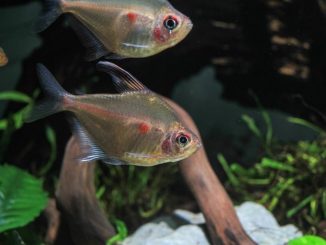
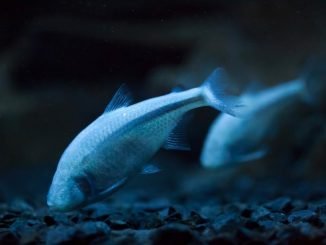
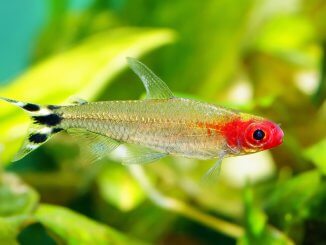
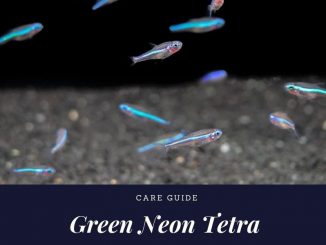
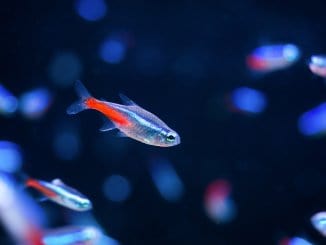
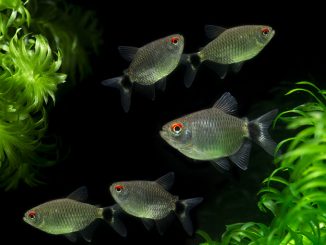
Be the first to comment